NUR341 Aging Case Study: Falls, Assessments, and Health of Mr. Jungala
VerifiedAdded on 2023/06/04
|13
|3826
|160
Case Study
AI Summary
This case study assesses Mr. Willie Jungala, a 71-year-old patient admitted after a fall, focusing on alcohol withdrawal risk, cognitive function, fall risk factors, and functional ability. It explores the potential causes of his fall, including his medical history of hypertension, type 2 diabetes, and unstable angina, as well as the impact on his psychological well-being. Various assessment tools like CIWA, MoCA, and Tinetti Gait are discussed. The study emphasizes a biopsychosocial approach, highlighting the importance of family support and healthcare professionals in managing the health challenges associated with aging, including chronic conditions and mental health issues like anxiety. The case study also touches on promoting physical and mental health through lifestyle adjustments and social support.

Running head: AGING
Student name
Student No
Unit
Title: Aging and Challenges Accompanying Aging Process
Student name
Student No
Unit
Title: Aging and Challenges Accompanying Aging Process
Paraphrase This Document
Need a fresh take? Get an instant paraphrase of this document with our AI Paraphraser
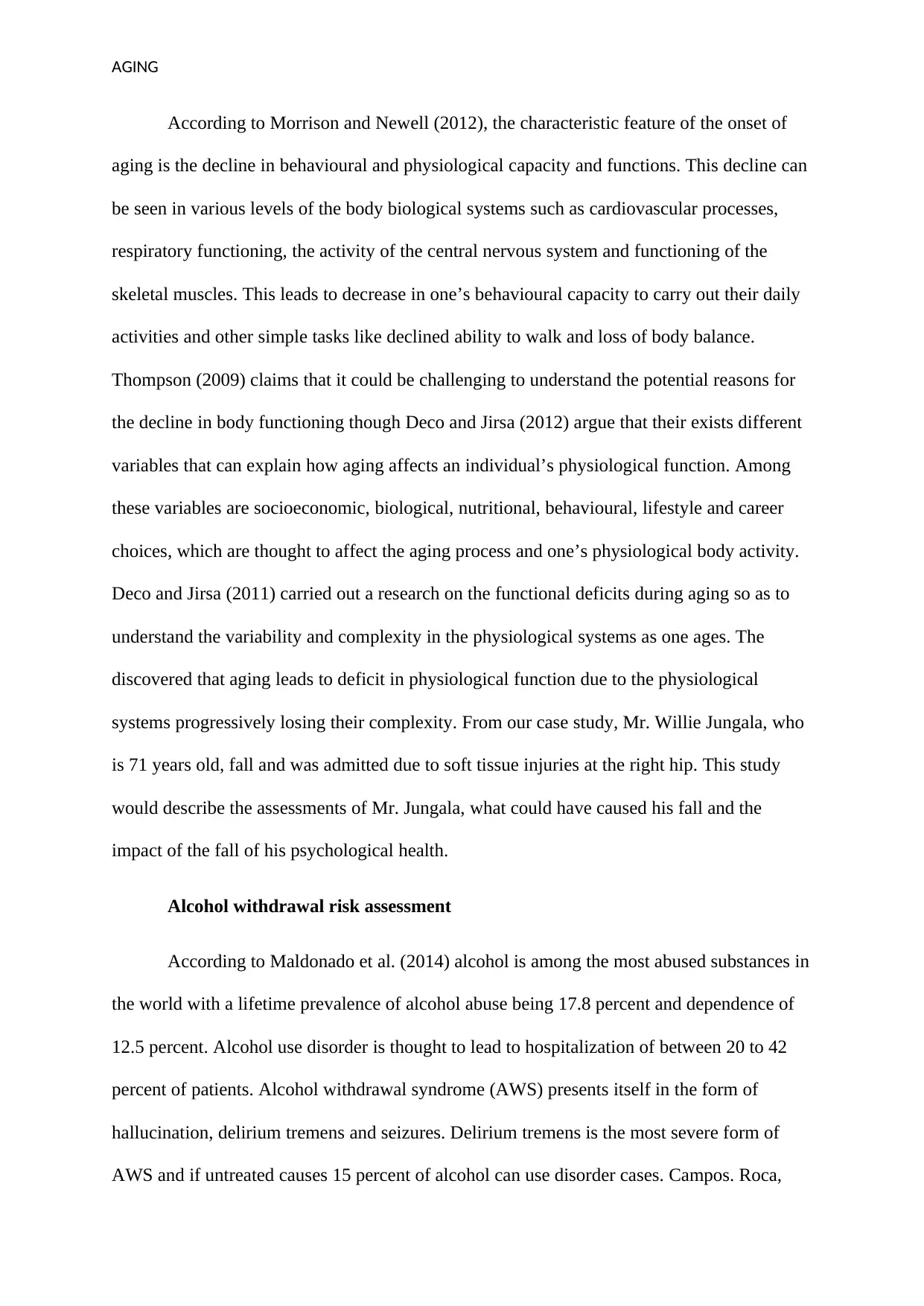
AGING
According to Morrison and Newell (2012), the characteristic feature of the onset of
aging is the decline in behavioural and physiological capacity and functions. This decline can
be seen in various levels of the body biological systems such as cardiovascular processes,
respiratory functioning, the activity of the central nervous system and functioning of the
skeletal muscles. This leads to decrease in one’s behavioural capacity to carry out their daily
activities and other simple tasks like declined ability to walk and loss of body balance.
Thompson (2009) claims that it could be challenging to understand the potential reasons for
the decline in body functioning though Deco and Jirsa (2012) argue that their exists different
variables that can explain how aging affects an individual’s physiological function. Among
these variables are socioeconomic, biological, nutritional, behavioural, lifestyle and career
choices, which are thought to affect the aging process and one’s physiological body activity.
Deco and Jirsa (2011) carried out a research on the functional deficits during aging so as to
understand the variability and complexity in the physiological systems as one ages. The
discovered that aging leads to deficit in physiological function due to the physiological
systems progressively losing their complexity. From our case study, Mr. Willie Jungala, who
is 71 years old, fall and was admitted due to soft tissue injuries at the right hip. This study
would describe the assessments of Mr. Jungala, what could have caused his fall and the
impact of the fall of his psychological health.
Alcohol withdrawal risk assessment
According to Maldonado et al. (2014) alcohol is among the most abused substances in
the world with a lifetime prevalence of alcohol abuse being 17.8 percent and dependence of
12.5 percent. Alcohol use disorder is thought to lead to hospitalization of between 20 to 42
percent of patients. Alcohol withdrawal syndrome (AWS) presents itself in the form of
hallucination, delirium tremens and seizures. Delirium tremens is the most severe form of
AWS and if untreated causes 15 percent of alcohol can use disorder cases. Campos. Roca,
According to Morrison and Newell (2012), the characteristic feature of the onset of
aging is the decline in behavioural and physiological capacity and functions. This decline can
be seen in various levels of the body biological systems such as cardiovascular processes,
respiratory functioning, the activity of the central nervous system and functioning of the
skeletal muscles. This leads to decrease in one’s behavioural capacity to carry out their daily
activities and other simple tasks like declined ability to walk and loss of body balance.
Thompson (2009) claims that it could be challenging to understand the potential reasons for
the decline in body functioning though Deco and Jirsa (2012) argue that their exists different
variables that can explain how aging affects an individual’s physiological function. Among
these variables are socioeconomic, biological, nutritional, behavioural, lifestyle and career
choices, which are thought to affect the aging process and one’s physiological body activity.
Deco and Jirsa (2011) carried out a research on the functional deficits during aging so as to
understand the variability and complexity in the physiological systems as one ages. The
discovered that aging leads to deficit in physiological function due to the physiological
systems progressively losing their complexity. From our case study, Mr. Willie Jungala, who
is 71 years old, fall and was admitted due to soft tissue injuries at the right hip. This study
would describe the assessments of Mr. Jungala, what could have caused his fall and the
impact of the fall of his psychological health.
Alcohol withdrawal risk assessment
According to Maldonado et al. (2014) alcohol is among the most abused substances in
the world with a lifetime prevalence of alcohol abuse being 17.8 percent and dependence of
12.5 percent. Alcohol use disorder is thought to lead to hospitalization of between 20 to 42
percent of patients. Alcohol withdrawal syndrome (AWS) presents itself in the form of
hallucination, delirium tremens and seizures. Delirium tremens is the most severe form of
AWS and if untreated causes 15 percent of alcohol can use disorder cases. Campos. Roca,
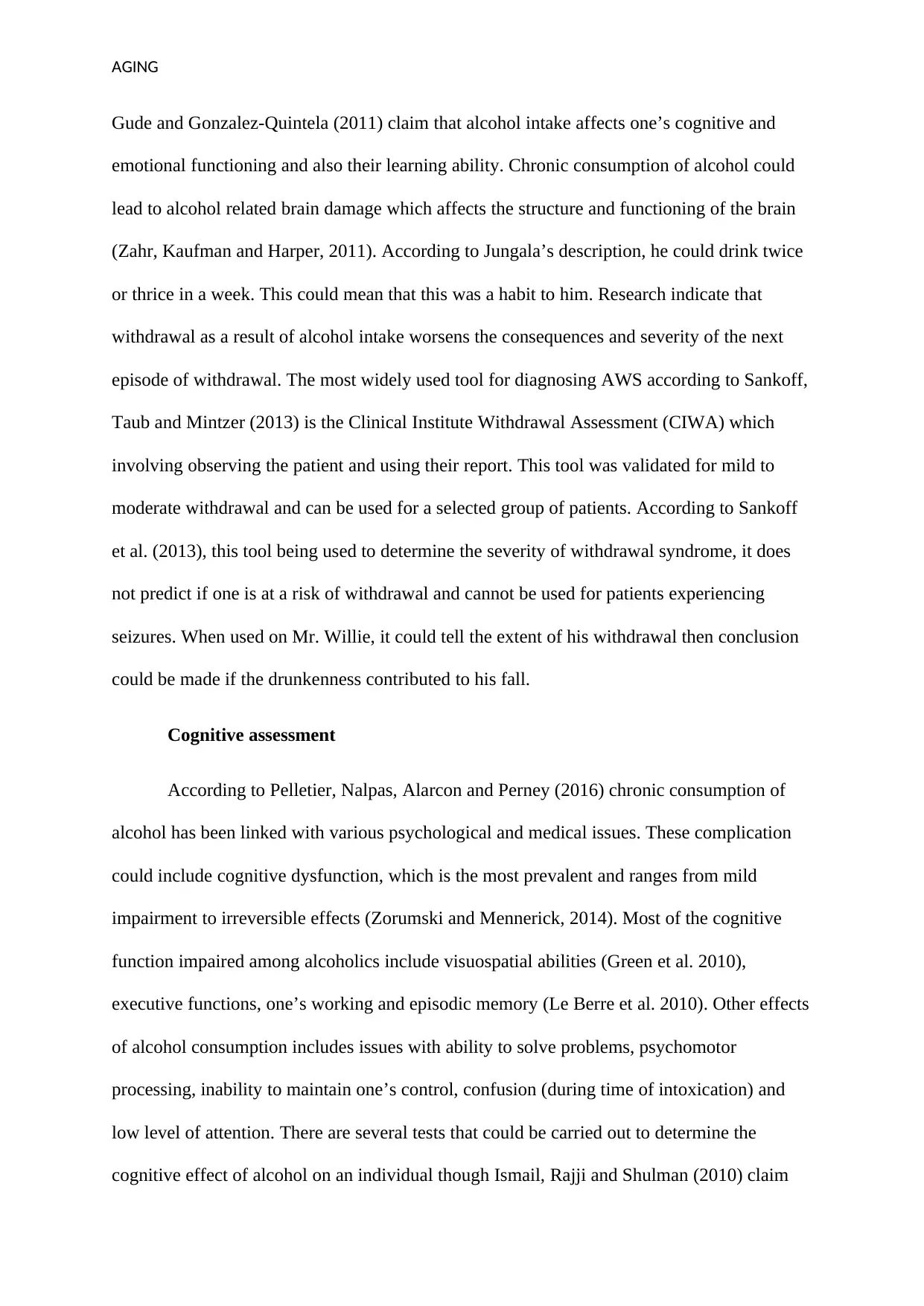
AGING
Gude and Gonzalez-Quintela (2011) claim that alcohol intake affects one’s cognitive and
emotional functioning and also their learning ability. Chronic consumption of alcohol could
lead to alcohol related brain damage which affects the structure and functioning of the brain
(Zahr, Kaufman and Harper, 2011). According to Jungala’s description, he could drink twice
or thrice in a week. This could mean that this was a habit to him. Research indicate that
withdrawal as a result of alcohol intake worsens the consequences and severity of the next
episode of withdrawal. The most widely used tool for diagnosing AWS according to Sankoff,
Taub and Mintzer (2013) is the Clinical Institute Withdrawal Assessment (CIWA) which
involving observing the patient and using their report. This tool was validated for mild to
moderate withdrawal and can be used for a selected group of patients. According to Sankoff
et al. (2013), this tool being used to determine the severity of withdrawal syndrome, it does
not predict if one is at a risk of withdrawal and cannot be used for patients experiencing
seizures. When used on Mr. Willie, it could tell the extent of his withdrawal then conclusion
could be made if the drunkenness contributed to his fall.
Cognitive assessment
According to Pelletier, Nalpas, Alarcon and Perney (2016) chronic consumption of
alcohol has been linked with various psychological and medical issues. These complication
could include cognitive dysfunction, which is the most prevalent and ranges from mild
impairment to irreversible effects (Zorumski and Mennerick, 2014). Most of the cognitive
function impaired among alcoholics include visuospatial abilities (Green et al. 2010),
executive functions, one’s working and episodic memory (Le Berre et al. 2010). Other effects
of alcohol consumption includes issues with ability to solve problems, psychomotor
processing, inability to maintain one’s control, confusion (during time of intoxication) and
low level of attention. There are several tests that could be carried out to determine the
cognitive effect of alcohol on an individual though Ismail, Rajji and Shulman (2010) claim
Gude and Gonzalez-Quintela (2011) claim that alcohol intake affects one’s cognitive and
emotional functioning and also their learning ability. Chronic consumption of alcohol could
lead to alcohol related brain damage which affects the structure and functioning of the brain
(Zahr, Kaufman and Harper, 2011). According to Jungala’s description, he could drink twice
or thrice in a week. This could mean that this was a habit to him. Research indicate that
withdrawal as a result of alcohol intake worsens the consequences and severity of the next
episode of withdrawal. The most widely used tool for diagnosing AWS according to Sankoff,
Taub and Mintzer (2013) is the Clinical Institute Withdrawal Assessment (CIWA) which
involving observing the patient and using their report. This tool was validated for mild to
moderate withdrawal and can be used for a selected group of patients. According to Sankoff
et al. (2013), this tool being used to determine the severity of withdrawal syndrome, it does
not predict if one is at a risk of withdrawal and cannot be used for patients experiencing
seizures. When used on Mr. Willie, it could tell the extent of his withdrawal then conclusion
could be made if the drunkenness contributed to his fall.
Cognitive assessment
According to Pelletier, Nalpas, Alarcon and Perney (2016) chronic consumption of
alcohol has been linked with various psychological and medical issues. These complication
could include cognitive dysfunction, which is the most prevalent and ranges from mild
impairment to irreversible effects (Zorumski and Mennerick, 2014). Most of the cognitive
function impaired among alcoholics include visuospatial abilities (Green et al. 2010),
executive functions, one’s working and episodic memory (Le Berre et al. 2010). Other effects
of alcohol consumption includes issues with ability to solve problems, psychomotor
processing, inability to maintain one’s control, confusion (during time of intoxication) and
low level of attention. There are several tests that could be carried out to determine the
cognitive effect of alcohol on an individual though Ismail, Rajji and Shulman (2010) claim
⊘ This is a preview!⊘
Do you want full access?
Subscribe today to unlock all pages.

Trusted by 1+ million students worldwide
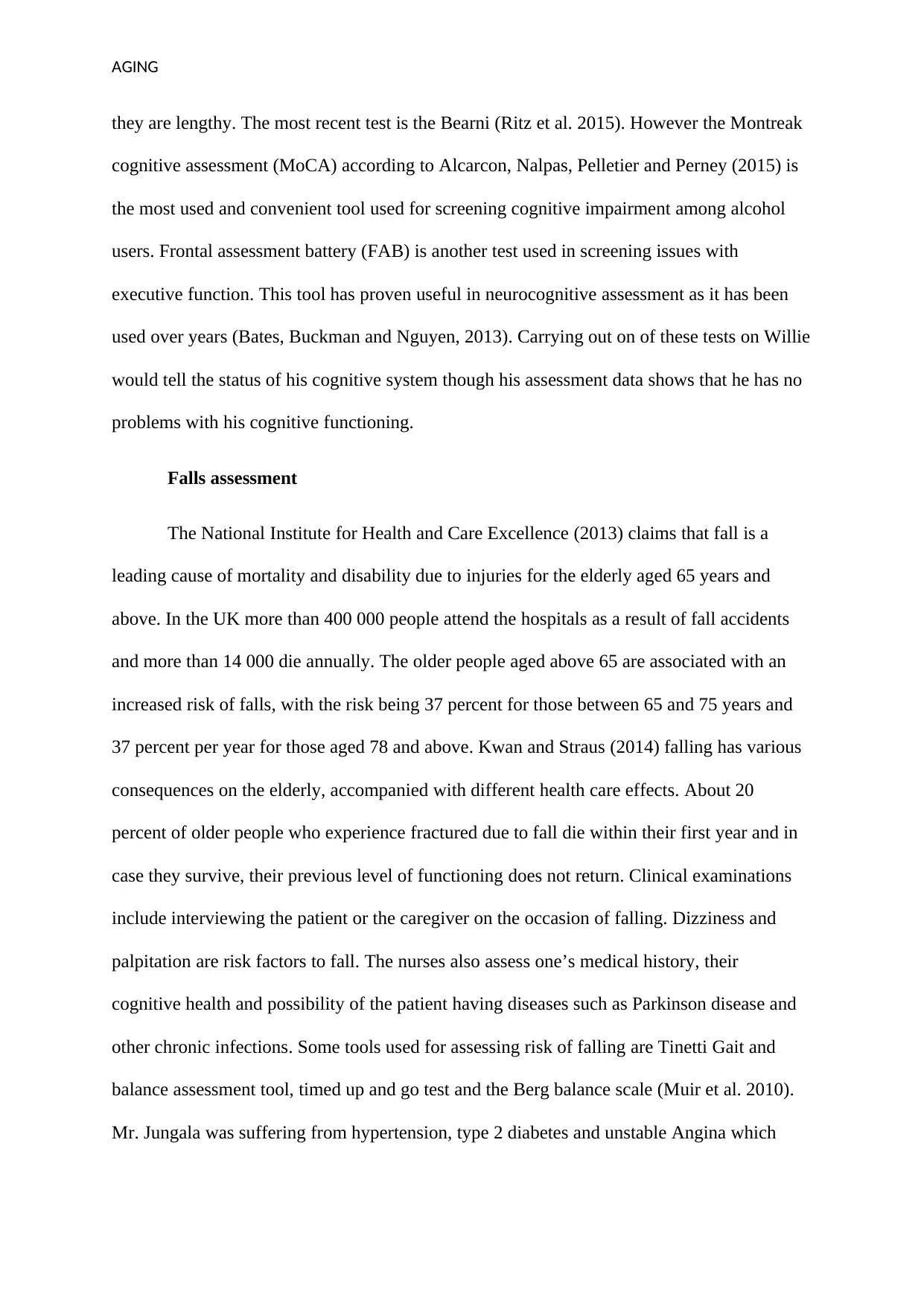
AGING
they are lengthy. The most recent test is the Bearni (Ritz et al. 2015). However the Montreak
cognitive assessment (MoCA) according to Alcarcon, Nalpas, Pelletier and Perney (2015) is
the most used and convenient tool used for screening cognitive impairment among alcohol
users. Frontal assessment battery (FAB) is another test used in screening issues with
executive function. This tool has proven useful in neurocognitive assessment as it has been
used over years (Bates, Buckman and Nguyen, 2013). Carrying out on of these tests on Willie
would tell the status of his cognitive system though his assessment data shows that he has no
problems with his cognitive functioning.
Falls assessment
The National Institute for Health and Care Excellence (2013) claims that fall is a
leading cause of mortality and disability due to injuries for the elderly aged 65 years and
above. In the UK more than 400 000 people attend the hospitals as a result of fall accidents
and more than 14 000 die annually. The older people aged above 65 are associated with an
increased risk of falls, with the risk being 37 percent for those between 65 and 75 years and
37 percent per year for those aged 78 and above. Kwan and Straus (2014) falling has various
consequences on the elderly, accompanied with different health care effects. About 20
percent of older people who experience fractured due to fall die within their first year and in
case they survive, their previous level of functioning does not return. Clinical examinations
include interviewing the patient or the caregiver on the occasion of falling. Dizziness and
palpitation are risk factors to fall. The nurses also assess one’s medical history, their
cognitive health and possibility of the patient having diseases such as Parkinson disease and
other chronic infections. Some tools used for assessing risk of falling are Tinetti Gait and
balance assessment tool, timed up and go test and the Berg balance scale (Muir et al. 2010).
Mr. Jungala was suffering from hypertension, type 2 diabetes and unstable Angina which
they are lengthy. The most recent test is the Bearni (Ritz et al. 2015). However the Montreak
cognitive assessment (MoCA) according to Alcarcon, Nalpas, Pelletier and Perney (2015) is
the most used and convenient tool used for screening cognitive impairment among alcohol
users. Frontal assessment battery (FAB) is another test used in screening issues with
executive function. This tool has proven useful in neurocognitive assessment as it has been
used over years (Bates, Buckman and Nguyen, 2013). Carrying out on of these tests on Willie
would tell the status of his cognitive system though his assessment data shows that he has no
problems with his cognitive functioning.
Falls assessment
The National Institute for Health and Care Excellence (2013) claims that fall is a
leading cause of mortality and disability due to injuries for the elderly aged 65 years and
above. In the UK more than 400 000 people attend the hospitals as a result of fall accidents
and more than 14 000 die annually. The older people aged above 65 are associated with an
increased risk of falls, with the risk being 37 percent for those between 65 and 75 years and
37 percent per year for those aged 78 and above. Kwan and Straus (2014) falling has various
consequences on the elderly, accompanied with different health care effects. About 20
percent of older people who experience fractured due to fall die within their first year and in
case they survive, their previous level of functioning does not return. Clinical examinations
include interviewing the patient or the caregiver on the occasion of falling. Dizziness and
palpitation are risk factors to fall. The nurses also assess one’s medical history, their
cognitive health and possibility of the patient having diseases such as Parkinson disease and
other chronic infections. Some tools used for assessing risk of falling are Tinetti Gait and
balance assessment tool, timed up and go test and the Berg balance scale (Muir et al. 2010).
Mr. Jungala was suffering from hypertension, type 2 diabetes and unstable Angina which
Paraphrase This Document
Need a fresh take? Get an instant paraphrase of this document with our AI Paraphraser
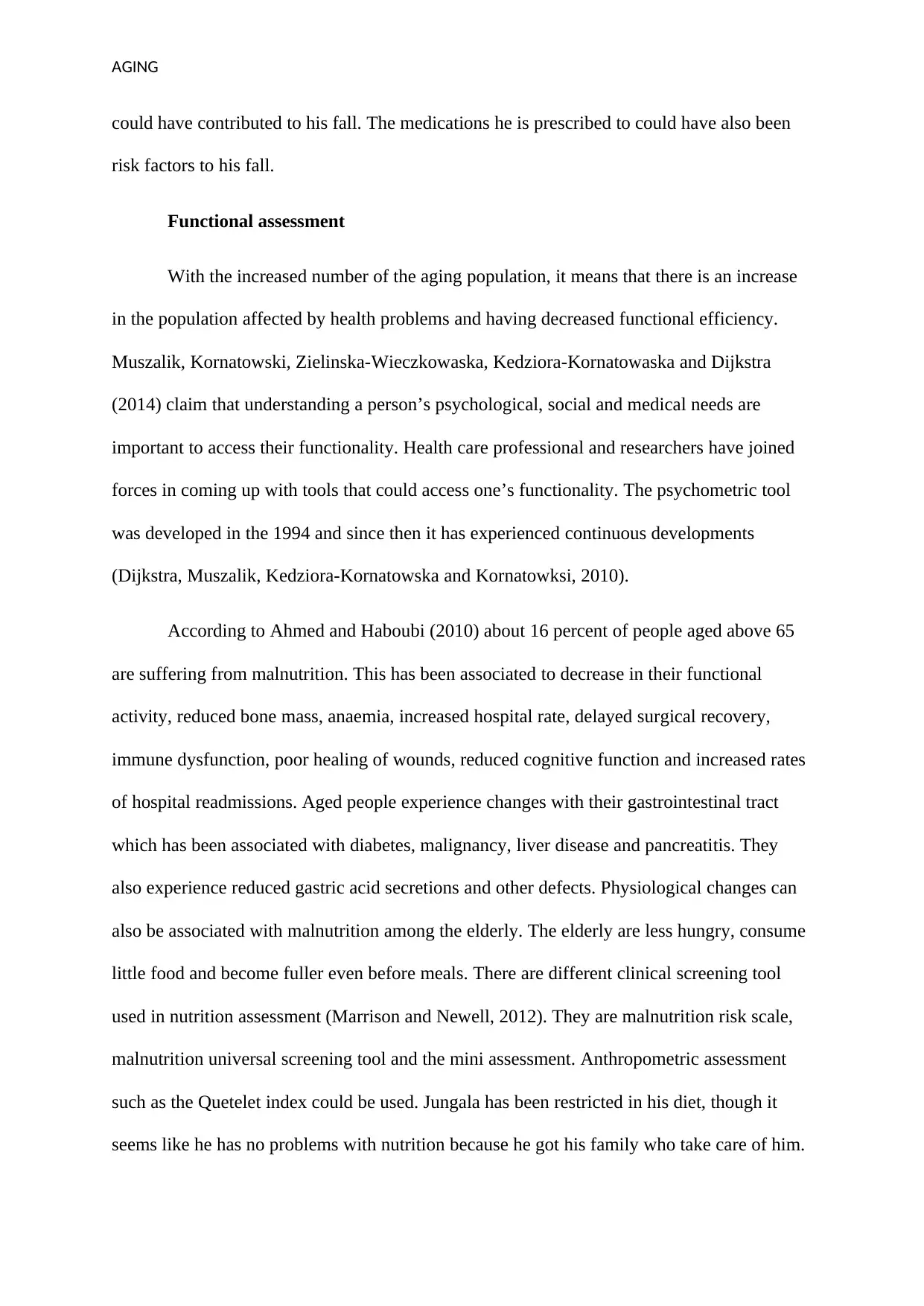
AGING
could have contributed to his fall. The medications he is prescribed to could have also been
risk factors to his fall.
Functional assessment
With the increased number of the aging population, it means that there is an increase
in the population affected by health problems and having decreased functional efficiency.
Muszalik, Kornatowski, Zielinska-Wieczkowaska, Kedziora-Kornatowaska and Dijkstra
(2014) claim that understanding a person’s psychological, social and medical needs are
important to access their functionality. Health care professional and researchers have joined
forces in coming up with tools that could access one’s functionality. The psychometric tool
was developed in the 1994 and since then it has experienced continuous developments
(Dijkstra, Muszalik, Kedziora-Kornatowska and Kornatowksi, 2010).
According to Ahmed and Haboubi (2010) about 16 percent of people aged above 65
are suffering from malnutrition. This has been associated to decrease in their functional
activity, reduced bone mass, anaemia, increased hospital rate, delayed surgical recovery,
immune dysfunction, poor healing of wounds, reduced cognitive function and increased rates
of hospital readmissions. Aged people experience changes with their gastrointestinal tract
which has been associated with diabetes, malignancy, liver disease and pancreatitis. They
also experience reduced gastric acid secretions and other defects. Physiological changes can
also be associated with malnutrition among the elderly. The elderly are less hungry, consume
little food and become fuller even before meals. There are different clinical screening tool
used in nutrition assessment (Marrison and Newell, 2012). They are malnutrition risk scale,
malnutrition universal screening tool and the mini assessment. Anthropometric assessment
such as the Quetelet index could be used. Jungala has been restricted in his diet, though it
seems like he has no problems with nutrition because he got his family who take care of him.
could have contributed to his fall. The medications he is prescribed to could have also been
risk factors to his fall.
Functional assessment
With the increased number of the aging population, it means that there is an increase
in the population affected by health problems and having decreased functional efficiency.
Muszalik, Kornatowski, Zielinska-Wieczkowaska, Kedziora-Kornatowaska and Dijkstra
(2014) claim that understanding a person’s psychological, social and medical needs are
important to access their functionality. Health care professional and researchers have joined
forces in coming up with tools that could access one’s functionality. The psychometric tool
was developed in the 1994 and since then it has experienced continuous developments
(Dijkstra, Muszalik, Kedziora-Kornatowska and Kornatowksi, 2010).
According to Ahmed and Haboubi (2010) about 16 percent of people aged above 65
are suffering from malnutrition. This has been associated to decrease in their functional
activity, reduced bone mass, anaemia, increased hospital rate, delayed surgical recovery,
immune dysfunction, poor healing of wounds, reduced cognitive function and increased rates
of hospital readmissions. Aged people experience changes with their gastrointestinal tract
which has been associated with diabetes, malignancy, liver disease and pancreatitis. They
also experience reduced gastric acid secretions and other defects. Physiological changes can
also be associated with malnutrition among the elderly. The elderly are less hungry, consume
little food and become fuller even before meals. There are different clinical screening tool
used in nutrition assessment (Marrison and Newell, 2012). They are malnutrition risk scale,
malnutrition universal screening tool and the mini assessment. Anthropometric assessment
such as the Quetelet index could be used. Jungala has been restricted in his diet, though it
seems like he has no problems with nutrition because he got his family who take care of him.
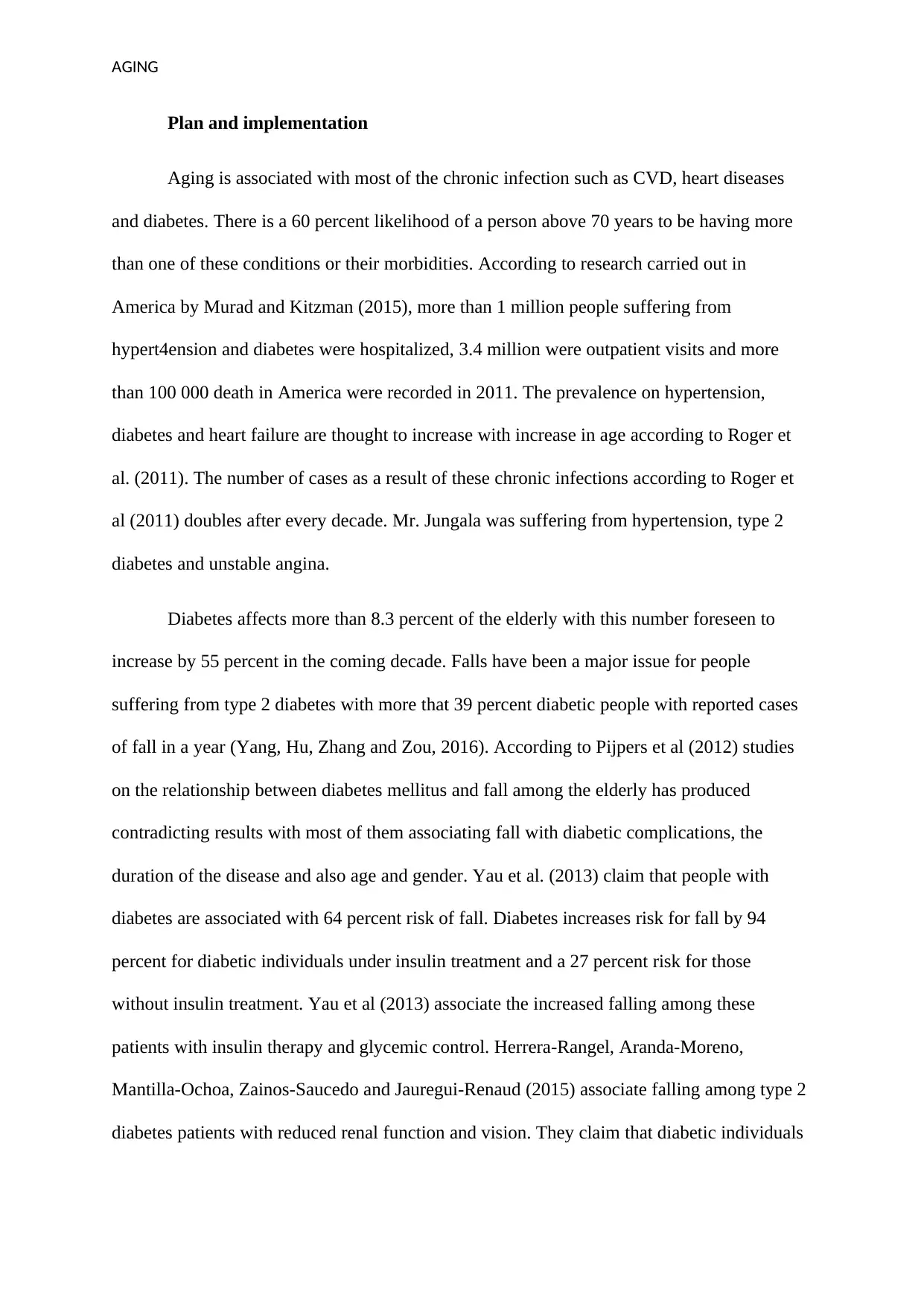
AGING
Plan and implementation
Aging is associated with most of the chronic infection such as CVD, heart diseases
and diabetes. There is a 60 percent likelihood of a person above 70 years to be having more
than one of these conditions or their morbidities. According to research carried out in
America by Murad and Kitzman (2015), more than 1 million people suffering from
hypert4ension and diabetes were hospitalized, 3.4 million were outpatient visits and more
than 100 000 death in America were recorded in 2011. The prevalence on hypertension,
diabetes and heart failure are thought to increase with increase in age according to Roger et
al. (2011). The number of cases as a result of these chronic infections according to Roger et
al (2011) doubles after every decade. Mr. Jungala was suffering from hypertension, type 2
diabetes and unstable angina.
Diabetes affects more than 8.3 percent of the elderly with this number foreseen to
increase by 55 percent in the coming decade. Falls have been a major issue for people
suffering from type 2 diabetes with more that 39 percent diabetic people with reported cases
of fall in a year (Yang, Hu, Zhang and Zou, 2016). According to Pijpers et al (2012) studies
on the relationship between diabetes mellitus and fall among the elderly has produced
contradicting results with most of them associating fall with diabetic complications, the
duration of the disease and also age and gender. Yau et al. (2013) claim that people with
diabetes are associated with 64 percent risk of fall. Diabetes increases risk for fall by 94
percent for diabetic individuals under insulin treatment and a 27 percent risk for those
without insulin treatment. Yau et al (2013) associate the increased falling among these
patients with insulin therapy and glycemic control. Herrera-Rangel, Aranda-Moreno,
Mantilla-Ochoa, Zainos-Saucedo and Jauregui-Renaud (2015) associate falling among type 2
diabetes patients with reduced renal function and vision. They claim that diabetic individuals
Plan and implementation
Aging is associated with most of the chronic infection such as CVD, heart diseases
and diabetes. There is a 60 percent likelihood of a person above 70 years to be having more
than one of these conditions or their morbidities. According to research carried out in
America by Murad and Kitzman (2015), more than 1 million people suffering from
hypert4ension and diabetes were hospitalized, 3.4 million were outpatient visits and more
than 100 000 death in America were recorded in 2011. The prevalence on hypertension,
diabetes and heart failure are thought to increase with increase in age according to Roger et
al. (2011). The number of cases as a result of these chronic infections according to Roger et
al (2011) doubles after every decade. Mr. Jungala was suffering from hypertension, type 2
diabetes and unstable angina.
Diabetes affects more than 8.3 percent of the elderly with this number foreseen to
increase by 55 percent in the coming decade. Falls have been a major issue for people
suffering from type 2 diabetes with more that 39 percent diabetic people with reported cases
of fall in a year (Yang, Hu, Zhang and Zou, 2016). According to Pijpers et al (2012) studies
on the relationship between diabetes mellitus and fall among the elderly has produced
contradicting results with most of them associating fall with diabetic complications, the
duration of the disease and also age and gender. Yau et al. (2013) claim that people with
diabetes are associated with 64 percent risk of fall. Diabetes increases risk for fall by 94
percent for diabetic individuals under insulin treatment and a 27 percent risk for those
without insulin treatment. Yau et al (2013) associate the increased falling among these
patients with insulin therapy and glycemic control. Herrera-Rangel, Aranda-Moreno,
Mantilla-Ochoa, Zainos-Saucedo and Jauregui-Renaud (2015) associate falling among type 2
diabetes patients with reduced renal function and vision. They claim that diabetic individuals
⊘ This is a preview!⊘
Do you want full access?
Subscribe today to unlock all pages.

Trusted by 1+ million students worldwide

AGING
have reduced strength, gait and balance. Just like Yau et al. (2013), Herrera-Rangel et al
(2015), they associate insulin therapy with increase falling among diabetic individuals.
A biopsychosocial approach
Han et al. (2015) claim that every developmental stage of life in humans is affected by
the previous. Therefore the quality of life when one ages is affected by their lifestyle in the
previous years. They continue that every person wants a successful aging (it is a goal of old
age) and health aging, which is a continuous process of health aging. Health aging extends
beyond being free from infections to mental, social and physical well-being. Kim (2013)
thinks that factors such as self-esteem, depression, loneliness, self-efficacy and isolation
influence the psychosocial life of the elderly. Anxiety is another factor as evident in Mr.
Jungala’s case. Old people’s well-being and mortality influenced by their belief on their
health, with those who think their health being positive showing less mortality and high
levels of well-being. Psychological factors such as ego-integrity and self-achievements are
important for health aging (Orth, Robins and Widaman, 2012). Psychosocial factors such as
anxiety, stress, poor relationships and isolation are associated with increased risks of
diabetes, hypertension and CVDs among the elderly (Ross, Jennings and Williams, 2017). To
prevent these, the elderly needs a maximum support from family members. Mr. Willie has
support from his family members though he has medium level anxiety. He claims that he got
all the support he wants from his wife and children who help him in his activities despite one
of them being diagnosed with cancer which stresses him. In his care team, a health
professional is crucial. They would give medical and health care advice.
According to Rantanen (2013) there are different ways to promote the physical health
of the elderly. These include regular exercise, ensuring they get sufficient sleep, avoiding
smoking, maintaining health weight, avoiding life stressors and maintaining a healthy diet.
have reduced strength, gait and balance. Just like Yau et al. (2013), Herrera-Rangel et al
(2015), they associate insulin therapy with increase falling among diabetic individuals.
A biopsychosocial approach
Han et al. (2015) claim that every developmental stage of life in humans is affected by
the previous. Therefore the quality of life when one ages is affected by their lifestyle in the
previous years. They continue that every person wants a successful aging (it is a goal of old
age) and health aging, which is a continuous process of health aging. Health aging extends
beyond being free from infections to mental, social and physical well-being. Kim (2013)
thinks that factors such as self-esteem, depression, loneliness, self-efficacy and isolation
influence the psychosocial life of the elderly. Anxiety is another factor as evident in Mr.
Jungala’s case. Old people’s well-being and mortality influenced by their belief on their
health, with those who think their health being positive showing less mortality and high
levels of well-being. Psychological factors such as ego-integrity and self-achievements are
important for health aging (Orth, Robins and Widaman, 2012). Psychosocial factors such as
anxiety, stress, poor relationships and isolation are associated with increased risks of
diabetes, hypertension and CVDs among the elderly (Ross, Jennings and Williams, 2017). To
prevent these, the elderly needs a maximum support from family members. Mr. Willie has
support from his family members though he has medium level anxiety. He claims that he got
all the support he wants from his wife and children who help him in his activities despite one
of them being diagnosed with cancer which stresses him. In his care team, a health
professional is crucial. They would give medical and health care advice.
According to Rantanen (2013) there are different ways to promote the physical health
of the elderly. These include regular exercise, ensuring they get sufficient sleep, avoiding
smoking, maintaining health weight, avoiding life stressors and maintaining a healthy diet.
Paraphrase This Document
Need a fresh take? Get an instant paraphrase of this document with our AI Paraphraser
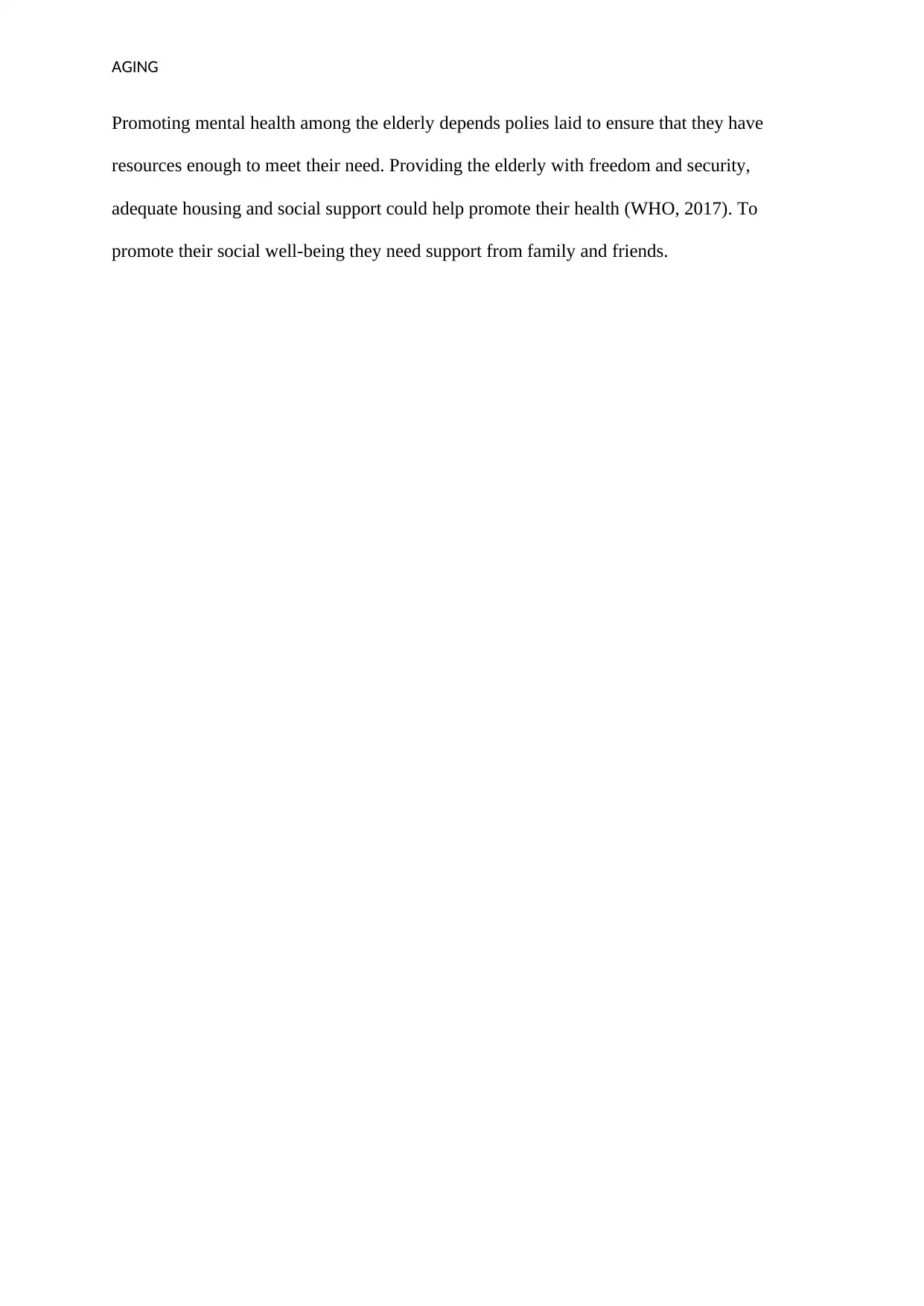
AGING
Promoting mental health among the elderly depends polies laid to ensure that they have
resources enough to meet their need. Providing the elderly with freedom and security,
adequate housing and social support could help promote their health (WHO, 2017). To
promote their social well-being they need support from family and friends.
Promoting mental health among the elderly depends polies laid to ensure that they have
resources enough to meet their need. Providing the elderly with freedom and security,
adequate housing and social support could help promote their health (WHO, 2017). To
promote their social well-being they need support from family and friends.
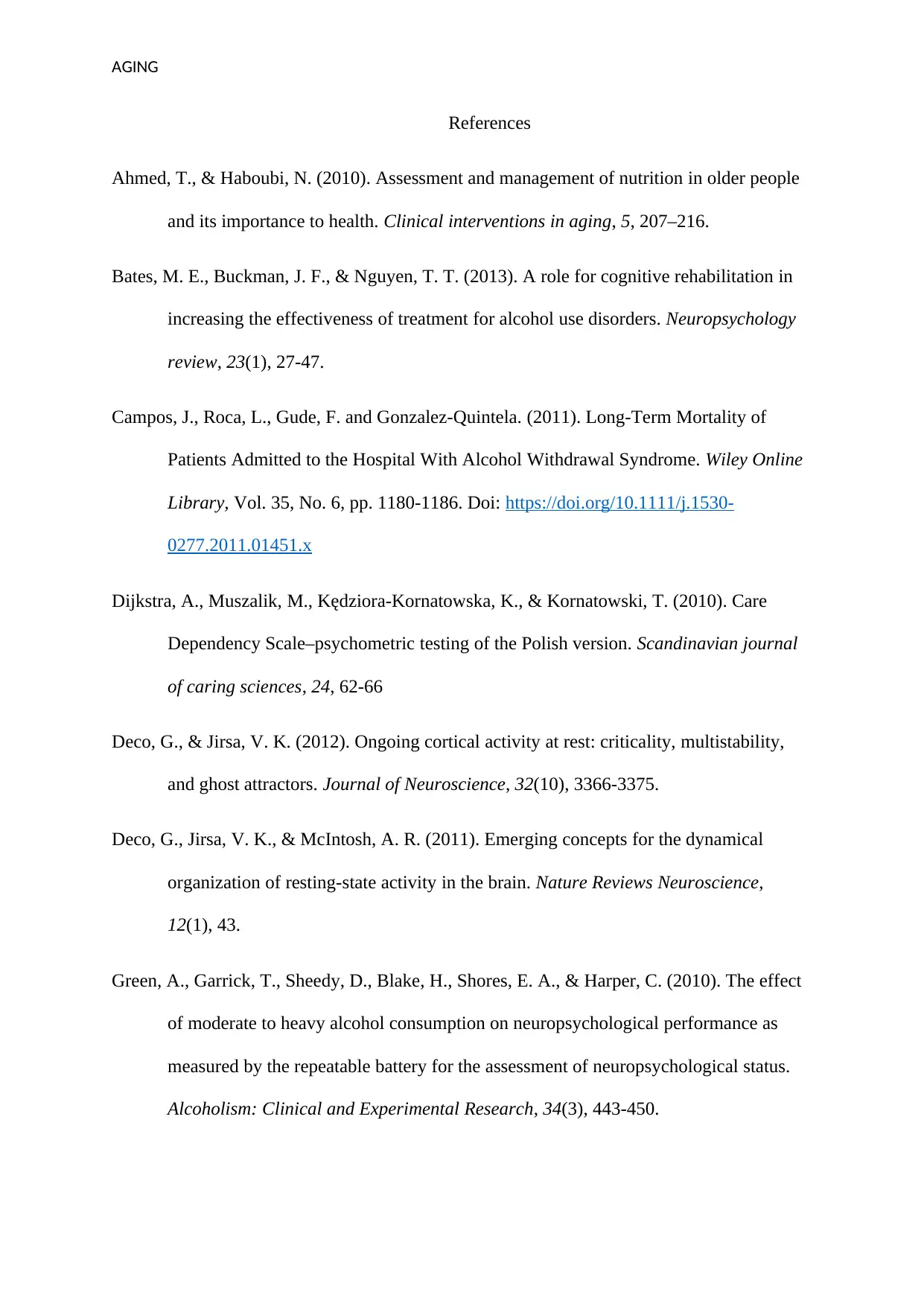
AGING
References
Ahmed, T., & Haboubi, N. (2010). Assessment and management of nutrition in older people
and its importance to health. Clinical interventions in aging, 5, 207–216.
Bates, M. E., Buckman, J. F., & Nguyen, T. T. (2013). A role for cognitive rehabilitation in
increasing the effectiveness of treatment for alcohol use disorders. Neuropsychology
review, 23(1), 27-47.
Campos, J., Roca, L., Gude, F. and Gonzalez-Quintela. (2011). Long‐Term Mortality of
Patients Admitted to the Hospital With Alcohol Withdrawal Syndrome. Wiley Online
Library, Vol. 35, No. 6, pp. 1180-1186. Doi: https://doi.org/10.1111/j.1530-
0277.2011.01451.x
Dijkstra, A., Muszalik, M., Kędziora‐Kornatowska, K., & Kornatowski, T. (2010). Care
Dependency Scale–psychometric testing of the Polish version. Scandinavian journal
of caring sciences, 24, 62-66
Deco, G., & Jirsa, V. K. (2012). Ongoing cortical activity at rest: criticality, multistability,
and ghost attractors. Journal of Neuroscience, 32(10), 3366-3375.
Deco, G., Jirsa, V. K., & McIntosh, A. R. (2011). Emerging concepts for the dynamical
organization of resting-state activity in the brain. Nature Reviews Neuroscience,
12(1), 43.
Green, A., Garrick, T., Sheedy, D., Blake, H., Shores, E. A., & Harper, C. (2010). The effect
of moderate to heavy alcohol consumption on neuropsychological performance as
measured by the repeatable battery for the assessment of neuropsychological status.
Alcoholism: Clinical and Experimental Research, 34(3), 443-450.
References
Ahmed, T., & Haboubi, N. (2010). Assessment and management of nutrition in older people
and its importance to health. Clinical interventions in aging, 5, 207–216.
Bates, M. E., Buckman, J. F., & Nguyen, T. T. (2013). A role for cognitive rehabilitation in
increasing the effectiveness of treatment for alcohol use disorders. Neuropsychology
review, 23(1), 27-47.
Campos, J., Roca, L., Gude, F. and Gonzalez-Quintela. (2011). Long‐Term Mortality of
Patients Admitted to the Hospital With Alcohol Withdrawal Syndrome. Wiley Online
Library, Vol. 35, No. 6, pp. 1180-1186. Doi: https://doi.org/10.1111/j.1530-
0277.2011.01451.x
Dijkstra, A., Muszalik, M., Kędziora‐Kornatowska, K., & Kornatowski, T. (2010). Care
Dependency Scale–psychometric testing of the Polish version. Scandinavian journal
of caring sciences, 24, 62-66
Deco, G., & Jirsa, V. K. (2012). Ongoing cortical activity at rest: criticality, multistability,
and ghost attractors. Journal of Neuroscience, 32(10), 3366-3375.
Deco, G., Jirsa, V. K., & McIntosh, A. R. (2011). Emerging concepts for the dynamical
organization of resting-state activity in the brain. Nature Reviews Neuroscience,
12(1), 43.
Green, A., Garrick, T., Sheedy, D., Blake, H., Shores, E. A., & Harper, C. (2010). The effect
of moderate to heavy alcohol consumption on neuropsychological performance as
measured by the repeatable battery for the assessment of neuropsychological status.
Alcoholism: Clinical and Experimental Research, 34(3), 443-450.
⊘ This is a preview!⊘
Do you want full access?
Subscribe today to unlock all pages.

Trusted by 1+ million students worldwide
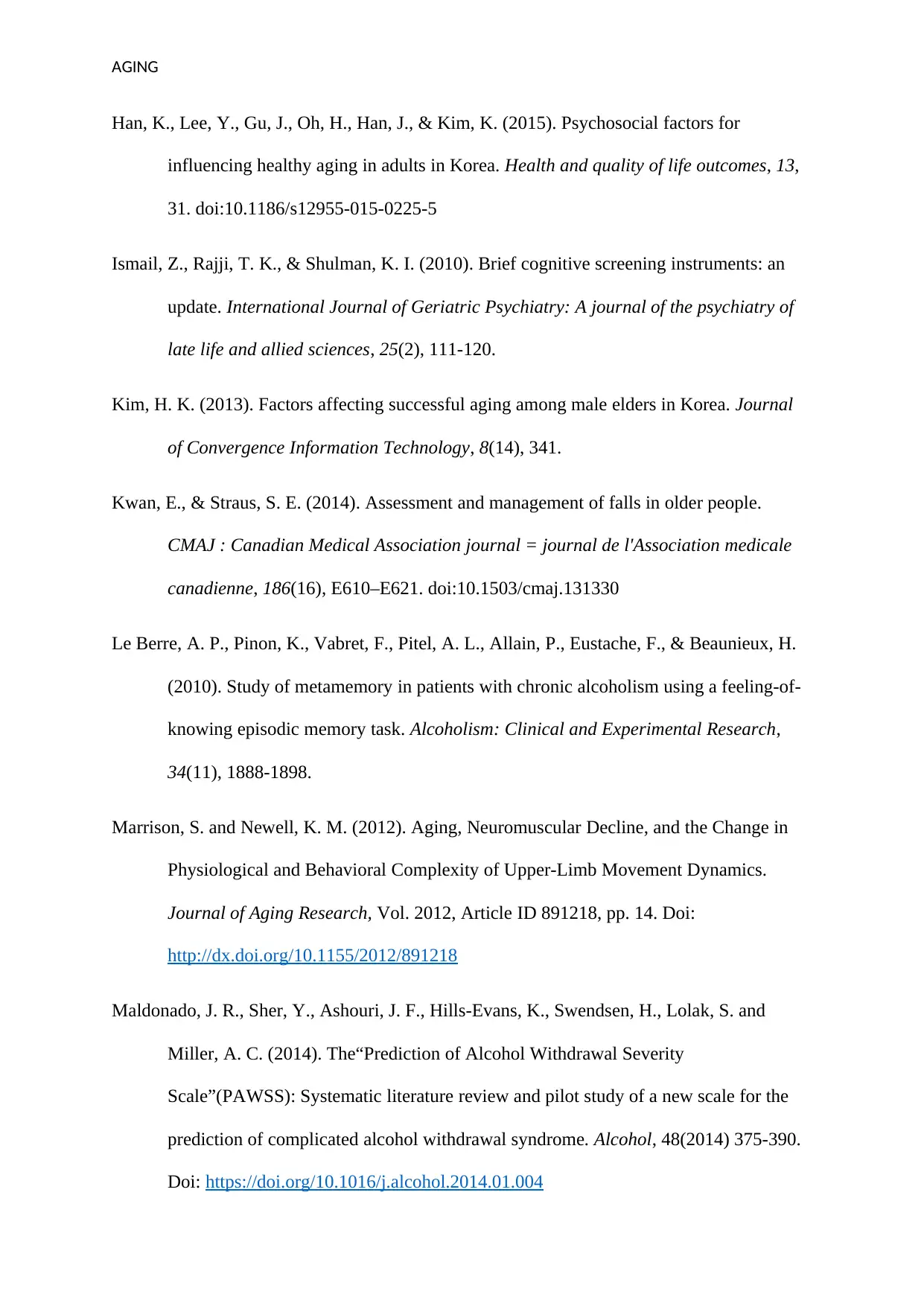
AGING
Han, K., Lee, Y., Gu, J., Oh, H., Han, J., & Kim, K. (2015). Psychosocial factors for
influencing healthy aging in adults in Korea. Health and quality of life outcomes, 13,
31. doi:10.1186/s12955-015-0225-5
Ismail, Z., Rajji, T. K., & Shulman, K. I. (2010). Brief cognitive screening instruments: an
update. International Journal of Geriatric Psychiatry: A journal of the psychiatry of
late life and allied sciences, 25(2), 111-120.
Kim, H. K. (2013). Factors affecting successful aging among male elders in Korea. Journal
of Convergence Information Technology, 8(14), 341.
Kwan, E., & Straus, S. E. (2014). Assessment and management of falls in older people.
CMAJ : Canadian Medical Association journal = journal de l'Association medicale
canadienne, 186(16), E610–E621. doi:10.1503/cmaj.131330
Le Berre, A. P., Pinon, K., Vabret, F., Pitel, A. L., Allain, P., Eustache, F., & Beaunieux, H.
(2010). Study of metamemory in patients with chronic alcoholism using a feeling‐of‐
knowing episodic memory task. Alcoholism: Clinical and Experimental Research,
34(11), 1888-1898.
Marrison, S. and Newell, K. M. (2012). Aging, Neuromuscular Decline, and the Change in
Physiological and Behavioral Complexity of Upper-Limb Movement Dynamics.
Journal of Aging Research, Vol. 2012, Article ID 891218, pp. 14. Doi:
http://dx.doi.org/10.1155/2012/891218
Maldonado, J. R., Sher, Y., Ashouri, J. F., Hills-Evans, K., Swendsen, H., Lolak, S. and
Miller, A. C. (2014). The“Prediction of Alcohol Withdrawal Severity
Scale”(PAWSS): Systematic literature review and pilot study of a new scale for the
prediction of complicated alcohol withdrawal syndrome. Alcohol, 48(2014) 375-390.
Doi: https://doi.org/10.1016/j.alcohol.2014.01.004
Han, K., Lee, Y., Gu, J., Oh, H., Han, J., & Kim, K. (2015). Psychosocial factors for
influencing healthy aging in adults in Korea. Health and quality of life outcomes, 13,
31. doi:10.1186/s12955-015-0225-5
Ismail, Z., Rajji, T. K., & Shulman, K. I. (2010). Brief cognitive screening instruments: an
update. International Journal of Geriatric Psychiatry: A journal of the psychiatry of
late life and allied sciences, 25(2), 111-120.
Kim, H. K. (2013). Factors affecting successful aging among male elders in Korea. Journal
of Convergence Information Technology, 8(14), 341.
Kwan, E., & Straus, S. E. (2014). Assessment and management of falls in older people.
CMAJ : Canadian Medical Association journal = journal de l'Association medicale
canadienne, 186(16), E610–E621. doi:10.1503/cmaj.131330
Le Berre, A. P., Pinon, K., Vabret, F., Pitel, A. L., Allain, P., Eustache, F., & Beaunieux, H.
(2010). Study of metamemory in patients with chronic alcoholism using a feeling‐of‐
knowing episodic memory task. Alcoholism: Clinical and Experimental Research,
34(11), 1888-1898.
Marrison, S. and Newell, K. M. (2012). Aging, Neuromuscular Decline, and the Change in
Physiological and Behavioral Complexity of Upper-Limb Movement Dynamics.
Journal of Aging Research, Vol. 2012, Article ID 891218, pp. 14. Doi:
http://dx.doi.org/10.1155/2012/891218
Maldonado, J. R., Sher, Y., Ashouri, J. F., Hills-Evans, K., Swendsen, H., Lolak, S. and
Miller, A. C. (2014). The“Prediction of Alcohol Withdrawal Severity
Scale”(PAWSS): Systematic literature review and pilot study of a new scale for the
prediction of complicated alcohol withdrawal syndrome. Alcohol, 48(2014) 375-390.
Doi: https://doi.org/10.1016/j.alcohol.2014.01.004
Paraphrase This Document
Need a fresh take? Get an instant paraphrase of this document with our AI Paraphraser
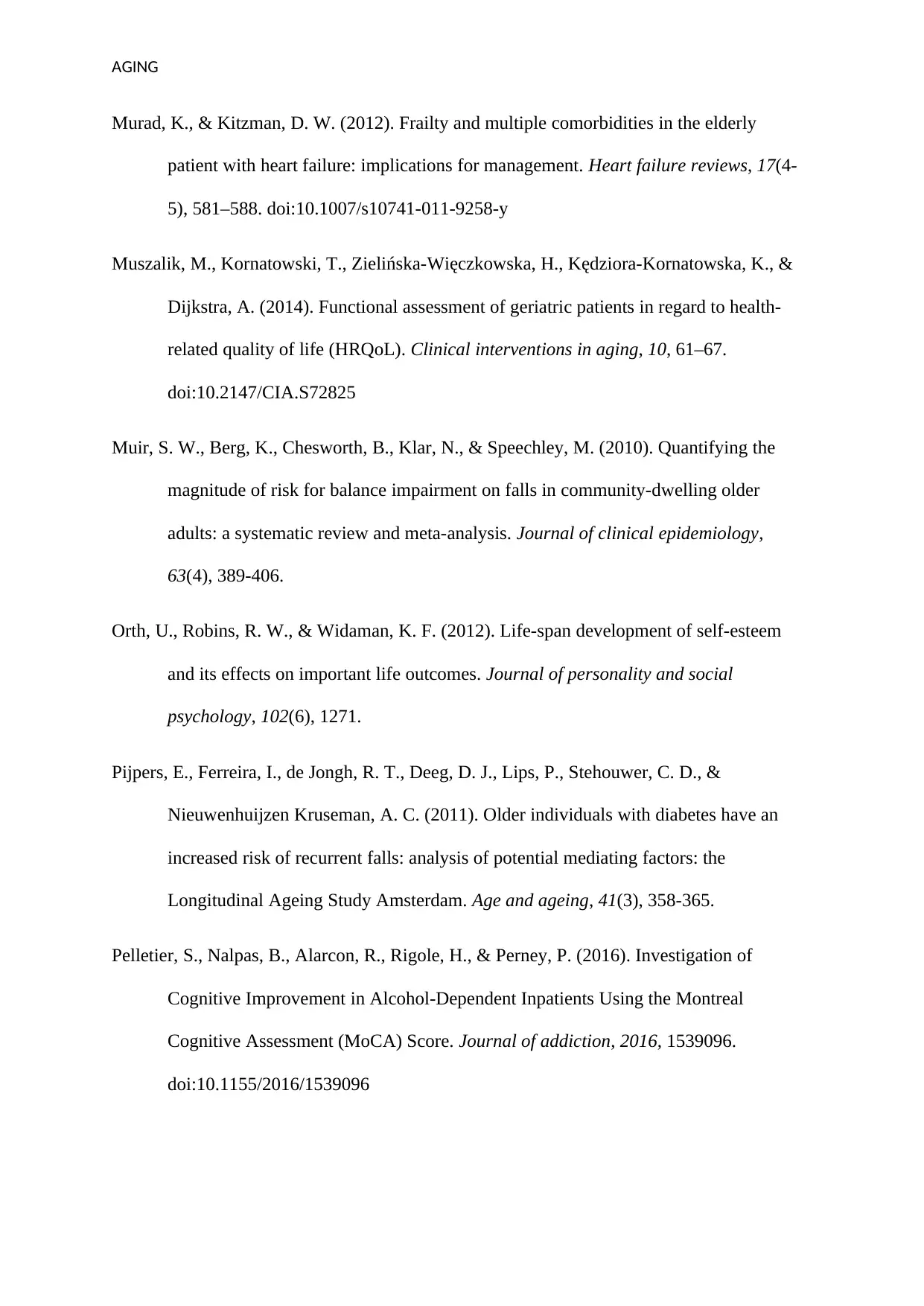
AGING
Murad, K., & Kitzman, D. W. (2012). Frailty and multiple comorbidities in the elderly
patient with heart failure: implications for management. Heart failure reviews, 17(4-
5), 581–588. doi:10.1007/s10741-011-9258-y
Muszalik, M., Kornatowski, T., Zielińska-Więczkowska, H., Kędziora-Kornatowska, K., &
Dijkstra, A. (2014). Functional assessment of geriatric patients in regard to health-
related quality of life (HRQoL). Clinical interventions in aging, 10, 61–67.
doi:10.2147/CIA.S72825
Muir, S. W., Berg, K., Chesworth, B., Klar, N., & Speechley, M. (2010). Quantifying the
magnitude of risk for balance impairment on falls in community-dwelling older
adults: a systematic review and meta-analysis. Journal of clinical epidemiology,
63(4), 389-406.
Orth, U., Robins, R. W., & Widaman, K. F. (2012). Life-span development of self-esteem
and its effects on important life outcomes. Journal of personality and social
psychology, 102(6), 1271.
Pijpers, E., Ferreira, I., de Jongh, R. T., Deeg, D. J., Lips, P., Stehouwer, C. D., &
Nieuwenhuijzen Kruseman, A. C. (2011). Older individuals with diabetes have an
increased risk of recurrent falls: analysis of potential mediating factors: the
Longitudinal Ageing Study Amsterdam. Age and ageing, 41(3), 358-365.
Pelletier, S., Nalpas, B., Alarcon, R., Rigole, H., & Perney, P. (2016). Investigation of
Cognitive Improvement in Alcohol-Dependent Inpatients Using the Montreal
Cognitive Assessment (MoCA) Score. Journal of addiction, 2016, 1539096.
doi:10.1155/2016/1539096
Murad, K., & Kitzman, D. W. (2012). Frailty and multiple comorbidities in the elderly
patient with heart failure: implications for management. Heart failure reviews, 17(4-
5), 581–588. doi:10.1007/s10741-011-9258-y
Muszalik, M., Kornatowski, T., Zielińska-Więczkowska, H., Kędziora-Kornatowska, K., &
Dijkstra, A. (2014). Functional assessment of geriatric patients in regard to health-
related quality of life (HRQoL). Clinical interventions in aging, 10, 61–67.
doi:10.2147/CIA.S72825
Muir, S. W., Berg, K., Chesworth, B., Klar, N., & Speechley, M. (2010). Quantifying the
magnitude of risk for balance impairment on falls in community-dwelling older
adults: a systematic review and meta-analysis. Journal of clinical epidemiology,
63(4), 389-406.
Orth, U., Robins, R. W., & Widaman, K. F. (2012). Life-span development of self-esteem
and its effects on important life outcomes. Journal of personality and social
psychology, 102(6), 1271.
Pijpers, E., Ferreira, I., de Jongh, R. T., Deeg, D. J., Lips, P., Stehouwer, C. D., &
Nieuwenhuijzen Kruseman, A. C. (2011). Older individuals with diabetes have an
increased risk of recurrent falls: analysis of potential mediating factors: the
Longitudinal Ageing Study Amsterdam. Age and ageing, 41(3), 358-365.
Pelletier, S., Nalpas, B., Alarcon, R., Rigole, H., & Perney, P. (2016). Investigation of
Cognitive Improvement in Alcohol-Dependent Inpatients Using the Montreal
Cognitive Assessment (MoCA) Score. Journal of addiction, 2016, 1539096.
doi:10.1155/2016/1539096

AGING
Rantanen T. (2013). Promoting mobility in older people. Journal of preventive medicine and
public health = Yebang Uihakhoe chi, 46 Suppl 1(Suppl 1), S50–S54.
doi:10.3961/jpmph.2013.46.S.S50
Roger, V. L., Go, A. S., Lloyd-Jones, D. M., Adams, R. J., Berry, J. D., Brown, T. M. & Fox,
C. S. (2011). Heart disease and stroke statistics—2011 update: a report from the
American Heart Association. Circulation, 123(4), e18-e209.
Ross, L., Jennings, P., & Williams, B. (2017). Psychosocial Support Issues Affecting Older
Patients: A Cross-sectional Paramedic Perspective. Inquiry : a journal of medical
care organization, provision and financing, 54, 46958017731963.
doi:10.1177/0046958017731963
Ritz, L., Lannuzel, C., Boudehent, C., Vabret, F., Bordas, N., Segobin, S. & Beaunieux, H.
(2015). Validation of a Brief Screening Tool for Alcohol‐Related Neuropsychological
Impairments. Alcoholism: clinical and experimental research, 39(11), 2249-2260.
The National Institute for Health and Care Excellence. (2013). Falls: Assessment and
Prevention of Falls in Older People. London: National Institute for Health and Care
Excellence. NICE Clinical Guidelines, No. 161.) 3, The assessment and prevention of
falls in older people. Available from:
https://www.ncbi.nlm.nih.gov/books/NBK327880/
Thompson, L. V. (2009). Age-related muscle dysfunction. Experimental gerontology, 44(1-
2), 106-111.
Volpato, S., Leveille, S. G., Blaum, C., Fried, L. P., & Guralnik, J. M. (2005). Risk factors
for falls in older disabled women with diabetes: the women's health and aging study.
The Journals of Gerontology Series A: Biological Sciences and Medical Sciences,
60(12), 1539-1545.
Rantanen T. (2013). Promoting mobility in older people. Journal of preventive medicine and
public health = Yebang Uihakhoe chi, 46 Suppl 1(Suppl 1), S50–S54.
doi:10.3961/jpmph.2013.46.S.S50
Roger, V. L., Go, A. S., Lloyd-Jones, D. M., Adams, R. J., Berry, J. D., Brown, T. M. & Fox,
C. S. (2011). Heart disease and stroke statistics—2011 update: a report from the
American Heart Association. Circulation, 123(4), e18-e209.
Ross, L., Jennings, P., & Williams, B. (2017). Psychosocial Support Issues Affecting Older
Patients: A Cross-sectional Paramedic Perspective. Inquiry : a journal of medical
care organization, provision and financing, 54, 46958017731963.
doi:10.1177/0046958017731963
Ritz, L., Lannuzel, C., Boudehent, C., Vabret, F., Bordas, N., Segobin, S. & Beaunieux, H.
(2015). Validation of a Brief Screening Tool for Alcohol‐Related Neuropsychological
Impairments. Alcoholism: clinical and experimental research, 39(11), 2249-2260.
The National Institute for Health and Care Excellence. (2013). Falls: Assessment and
Prevention of Falls in Older People. London: National Institute for Health and Care
Excellence. NICE Clinical Guidelines, No. 161.) 3, The assessment and prevention of
falls in older people. Available from:
https://www.ncbi.nlm.nih.gov/books/NBK327880/
Thompson, L. V. (2009). Age-related muscle dysfunction. Experimental gerontology, 44(1-
2), 106-111.
Volpato, S., Leveille, S. G., Blaum, C., Fried, L. P., & Guralnik, J. M. (2005). Risk factors
for falls in older disabled women with diabetes: the women's health and aging study.
The Journals of Gerontology Series A: Biological Sciences and Medical Sciences,
60(12), 1539-1545.
⊘ This is a preview!⊘
Do you want full access?
Subscribe today to unlock all pages.

Trusted by 1+ million students worldwide
1 out of 13
Your All-in-One AI-Powered Toolkit for Academic Success.
+13062052269
info@desklib.com
Available 24*7 on WhatsApp / Email
![[object Object]](/_next/static/media/star-bottom.7253800d.svg)
Unlock your academic potential
Copyright © 2020–2025 A2Z Services. All Rights Reserved. Developed and managed by ZUCOL.
